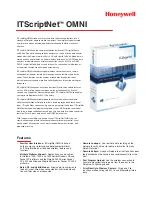
HD Player
Index
115
Rev. 6.8
in MPEG-1 and MPEG-2. A group of picture blocks, usually four, which are
analyzed during MPEG coding to give an estimate of the movement between
frames. This generates the motion vectors that are then used to place the
macroblocks in decoded pictures.
S
ee also: B frames, GOP, I frames, P frames.
MPEG-1
A group of picture blocks, usually four, which are analyzed during MPEG
coding to give an estimate of the movement between frames. This generates the
motion vectors that are then used to place the macroblocks in decoded pictures.
This was designed to work at 1.2 Mbps, the data rate of CD-ROM, so that video
could be played from CDs. However the quality is not sufficient for TV
broadcast.
MPEG-2
This has been designed to cover a wide range of requirements from "VHS
quality" all the way to HDTV through a series of algorithm "profiles" and image
resolution "levels." With data rates of between 1.2 and 15 Mbps, there is intense
interest in the use of MPEG-2 for the digital transmission of television-including
HDTV-applications for which the system was conceived. Coding the video is
very complex, especially as it is required to keep the decoding at the reception
end as simple and inexpensive as possible. MPEG-2 is the compression used by
the ATSC and DVB standards. MPEG can offer better quality pictures at high
compression ratios than pure JPEG compression, but with the complexity of
decoding and especially coding and the 12-long group of pictures (GOP), it is
not an ideal compression system for editing. If any P or B frames are used then
even a cut will require the re-use of complex, and not perfect, MPEG coding.
However, MPEG Splicers are beginning to appear to alleviate this difficulty.
Of the five profiles and four levels creating a grid of 20 possible combinations,
11 have already been implemented. The variations these define are so wide that
it would not be practical to build a universal coder or decoder. Interest is now
focused on the Main profile, Main level, sometimes written as MP@ML, which
covers broadcast television formats up to 720 pixels x 576 lines at 30 frames per
second. These figures are quoted as maximums so 720 x 486 at 30 frames are
included, as are 720 x 576 at 25 frames. As the coding is intended for
transmission the economy of 4:2:0 sampling is used.
A recent addition to MPEG-2 is the studio profile. Designed for studio work it’s
sampling is 4:2:2. The studio profile is written as 422P@ML. To improve the
picture quality, higher bit rates are used. The first applications for this appear to
be in electronic news gathering (ENG), and with some video Players.
S
ee also: B frames, Compression, GOP, I frames, JPEG, P frames.
Multiplex
1.
To transmit two or more signals at the same time or on the same carrier
frequency.
2.
To combine two or more electrical signals into a single, composite
signal, such as ATSC multicasting.
Multiplexer
Device for combining two or more electrical signals into a single, composite
signal.
P frames
One of the three types of frames used in the coded MPEG-2 signal. These
contain only predictive information (not a whole picture) generated by looking at
the difference between the present frame and the previous one. They contain
much less data than the I frames and so help towards the low data rates that can
be achieved with the MPEG signal. To see the original picture corresponding to
a P frame a whole MPEG-2 GoP has to be decoded.
Содержание MS9200P
Страница 10: ......
Страница 78: ...HD Player Chapter 12 Remote Control Protocols 78 Rev 6 8 The Player will respond with OK or ERROR ...
Страница 88: ......
Страница 93: ...HD Player Chapter 14 Application Notes 93 Rev 6 8 ...










































